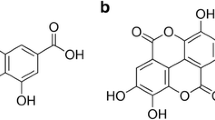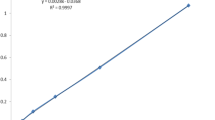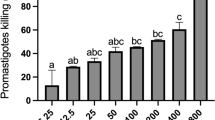Abstract
Leishmaniasis is one of the six major tropical diseases that is spreading geographically in the world, with no definitive cure. The aim of the present study was to investigate the anti-leishmanial effects of Olea europaea and Ficus carica extracts against Leishmania major in both in vitro and in vivo experimental models. The in vitro efficiency concentrations of 0.1–2 mg mL− 1 of O. europaea and F. carica extracts were effective against promastigote L. major at 48 h. In addition, the lesion size and parasite burden in BALB/c mice infected with promastigote of L. major were quantified for in vivo evaluation. Results showed that IC50 of O. europaea and F. carica extracts against promastigote were 1.5 and 1.2 mg mL− 1, respectively. In addition, results from in vivo assay revealed that the mean size ± SD of lesions significantly decreased to 3.46 ± 0.96 and 3.65 ± 0.9 mm2 in mice treated with O. europaea and F. carica extracts, respectively, compared with that in the untreated group (p = 0.001). Findings also indicated that O. europaea and F. carica extracts considerably lowered the parasite burden in lesions (p < 0.001), compared with the untreated group. Both extracts showed notable activity against L. major. However, further investigations are required to controlling CL and inhibiting the development of lesions.


Similar content being viewed by others
Abbreviations
- ANOVA:
-
Analysis of variance
- °C:
-
Celsius degree
- DMSO:
-
dimethyl sulfoxide
- IC50 :
-
50% inhibitory concentrations
- IFN-γ:
-
interferon-gamma
- kg:
-
kilogram
- mg:
-
milligram
- mL:
-
milliliters
- MA:
-
meglumine antimoniate
- SD:
-
Standard deviation
- SSG:
-
Sodium stibogluconate
- TGFβ:
-
transforming growth factor-β
- TNFα:
-
tumor necrosis factor-alpha
- USA:
-
United States
- VL:
-
visceral leishmaniasis
- WHO:
-
World Health Organization
References
Agabeĭli RA, Kasimova TE (2005) Antimutagenic activity of Armoracia rusticana, Zea mays and Ficus carica plant extracts and their mixture. Tsitol Genet 39:75–79
Alvar J, Vélez ID, Bern C, Herrero M, Desjeux P, Cano J, Jannin J, den Boer M (2012) Leishmaniasis worldwide and global estimates of its incidence. PLoS ONE 7:e35671. https://doi.org/10.1371/journal.pone.0035671
Akhlaghi L, Yeganeh M, Maleki F, Golestani M, Noori M, Ghelman M, Tabatabaie F (2014) Antileishmanial activity of Hyssopus officinalis, Tussilago farfara, Carum copticum extracts in mice infected with Leishmania major. Int J Herb Med 2(2):142–145
Akkol EK, Çankaya IT, Karatoprak G, Carpar E, Sobarzo-Sánchez E, Capasso R (2021) Natural compounds as medical strategies in the prevention and treatment of psychiatric disorders seen in neurological diseases. Front Pharmacol 12:669638. https://doi.org/10.3389/fphar.2021.669638
Amorin A, Borba HR, Carauta JP, Lopes D, Kaplan MA (1999) Anthelmintic activity of the latex of Ficus species. J Ethnopharmacol 64:255–258. https://doi.org/10.1016/S0378-8741(98)00139-1
Aref HL, Salah KBH, Chaumont JP, Fekih A, Aouni M, Said K (2010) In vitro antimicrobial activity of four Ficus carica latex fractions against resistant human pathogens (antimicrobial activity of Ficus carica latex). Pak J Pharm Sci 23:53–58
Asadi F, Pourkabir M, Maclaren R, Shahriari A (2006) Alterations to lipid parameters in response to fig tree (Ficus carica) leaf extract in chicken liver slices. Turk J Vet Anim Sci 30:315–318
Badgujar SB, Patel VV, Bandivdekar AH, Mahajan RT (2014) Traditional uses, phytochemistry and pharmacology of Ficus carica: a review. Pharm Biol 52:1487–1503. https://doi.org/10.3109/13880209.2014.892515
Badirzadeh A, Heidari-Kharaji M, Fallah-Omrani V, Dabiri H, Araghi A, Salimi Chirani A (2020) Antileishmanial activity of Urtica dioica extract against zoonotic cutaneous leishmaniasis. PLoS Negl Trop Dis 14:e0007843. https://doi.org/10.1371/journal.pntd.0007843
Ben Salem M, Affes H, Ksouda K, Sahnoun Z, Zeghal KM, Hammami S (2015) Pharmacological activities and Olea europaea leaf. J Food Process Preserv 39:3128–3136. https://doi.org/10.1111/jfpp.12341
Benavente-Garcıa O, Castillo J, Lorente J, Ortuño AD, Del Rio JA (2000) Antioxidant activity of phenolics extracted from Olea europaea L. leaves. Food Chem 68(99):457–462. https://doi.org/10.1016/S0308-8146
Cardinali A, Cicco N, Linsalata V, Minervini F, Pati S, Pieralice M, Tursi N, Lattanzio V (2010) Biological activity of high molecular weight phenolics from olive mill wastewater. J Agric Food Chem 58:8585–8590. https://doi.org/10.1021/jf101437c
Chiappetta A, Muzzalupo I (2012) Botanical Description. In: Muzzalupo I (ed) Olive Germplasm - The Olive Cultivation, Table Olive and Olive Oil Industry in Italy. InTech Open Book series, London, pp 78–112. https://doi.org/10.5772/51933
Dias DA, Urban S, Roessner U (2012) A historical overview of natural products in drug discovery. Metabolites 2:303–336. https://doi.org/10.3390/metabo2020303
Gond NY, Khadabadi SS (2008) Hepatoprotective activity of Ficus carica leaf extract on rifampicin-induced hepatic damage in rats. Indian J Pharm Sci 70:364–366. https://doi.org/10.4103/0250-474X.43003
Guo Z, Jia X, Zheng Z, Lu X, Zheng Y, Zheng B, Xiao J (2018) Chemical composition and nutritional function of olive (Olea europaea L.): A review. Phytochem Rev 17:1091–1110. https://doi.org/10.1007/s11101-017-9526-0
Hailu A, Dagne DA, Boelaert M (2016) Leishmaniasis. In: Gyapong J, Boatin B. (eds) Neglected tropical diseases - sub-Saharan Africa. Neglected Tropical Diseases. Springer, Berlin, pp 114–134. https://doi.org/10.1007/978-3-319-25471-5_5
Hossain S, Urbi Z, Karuniawati H, Mohiuddin RB, Moh Qrimida A, Allzrag AMM, Ming LC, Pagano E, Capasso R (2021) Andrographis paniculata (Burm. f.) Wall. ex Nees: An updated review of phytochemistry, antimicrobial pharmacology, and clinical safety and efficacy. Life (Basel) 11:348–360. https://doi.org/10.3390/life11040348
Iwu MM, Jackson JE, Schuster BG (1994) Medicinal plants in the fight against leishmaniasis. Parasitol Today 10(94):65–68. https://doi.org/10.1016/0169-4758
Jeong WS, Lachance PA (2001) Phytosterols and fatty acids in Fig (Ficus carica, var. Mission) fruit and tree components. J Food Sci 66:278–281. https://doi.org/10.1111/j.1365-2621.2001.tb11332.x
Keskin D, Ceyhan N, Uğur A, Dbeys AD (2012) Antimicrobial activity and chemical constitutions of West Anatolian olive (Olea europaea L.) leaves. J Food Agric Environ 10:99–102. https://doi.org/10.1234/4.2012.2896
Khadabadi SS, Gond NY, Ghiware NB, Shendarkar GR (2007) Hepatoprotective effect of Ficus carica leaf in chronic hepatitis. Indian Drugs 44:54–59
Kheirandish F, Mosaffa N, Tarahi MJ, Fallahi S (2018) Olive (Olea europaea) leaf extract alters the cytokine profile of Leishmania major-infected macrophages: New insight into the underlying mechanism. Parasite Immunol 40:e12520. https://doi.org/10.1111/pim.12520
Khoshzaban F, Ghaffarifar F, Jamshidi Koohsari HR (2014) Peganum harmala aqueous and ethanol extracts effects on lesions caused by Leishmania major (MRHO/IR/75/ER) in BALB/c mice. Jundishapur J Microbiol 7:e10992. https://doi.org/10.5812/jjm.10992
Liu F, Yang Z, Zheng X, Luo S, Zhang K, Li G (2011) Nematicidal coumarin from Ficus carica L. J Asia Pac Entomol 14:79–81. https://doi.org/10.1016/j.aspen.2010.10.006
Maleki F, Zarebavani M, Mohebali M, Dayer MS, Hajialiani F, Tabatabaie F (2017) In vitro and in vivo susceptibility of Leishmania major to some medicinal plants. Asian Pac J Trop Biomed 7:37–42. https://doi.org/10.1016/j.apjtb.2016.11.008
Mawa S, Husain K, Jantan I (2013) Ficus carica L. (Moraceae): Phytochemistry, traditional uses and biological activities. Evid Based Complement Alternat Med 2013:974256. https://doi.org/10.1155/2013/974256
McGwire BS, Satoskar AR (2014) Leishmaniasis: clinical syndromes and treatment. QJM 107:7–14. https://doi.org/10.1093/qjmed/hct116
Mishra J, Saxena A, Singh S (2007) Chemotherapy of leishmaniasis: Past, present and future. Curr Med Chem 14:1153–1169. https://doi.org/10.2174/092986707780362862
Mohamad S, Zin NM, Wahab HA, Ibrahim P, Sulaiman SF, Zahariluddin ASM, Noor SSM (2011) Antituberculosis potential of some ethnobotanically selected Malaysian plants. J Ethnopharmacol 133:1021–1026. https://doi.org/10.1016/j.jep.2010.11.037
Msomi NZ, Simelane MB (2017) Olea europaea subsp. africana (Oleaceae). Active ingredients from aromatic and medicinal plants. InTechOpen, London, UK. https://doi.org/10.5772/65725
Niazi M, Saki M, Sepahvand M, Jahanbakhsh S, Khatami M, Beyranvand M (2019) In vitro and ex vivo scolicidal effects of Olea europaea L. to inactivate the protoscolecs during hydatid cyst surgery. Ann Med Surg (Lond) 42:7–10. https://doi.org/10.1016/j.amsu.2019.04.006
Oliveira AP, Silva LR, Andrade PB, Valentão P, Silva BM, Gonçalves RF (2010) Further insight into the latex metabolite profile of Ficus carica. J Agric Food Chem 58:10855–10863. https://doi.org/10.1021/jf1031185
Oliveira AP, Valentão P, Pereira JA (2009a) Ficus carica L., metabolic and biological screening. Food Chem Toxicol 47:2841–2846. https://doi.org/10.1016/j.fct.2009.09.004
Oliveira AP, Valentão P, Pereira JA, Silva BM, Tavares F, Andrade PB (2009b) Ficus carica L.: Metabolic and biological screening. Food Chem Toxicol 47:2841–2846. https://doi.org/10.1016/j.fct.2009.09.004
Palumbo E (2009) Current treatment for cutaneous leishmaniasis: A review. Am J Ther 16:178–182. https://doi.org/10.1097/MJT.0b013e3181822e90
Patil Vikas V, Bhangale SC, Patil VR (2010) Evaluation of anti-pyretic potential of Ficus carica leaves. Int J Pharma Sci Rev Res 2:48–50
Pereira AP, Ferreira ICFR, Marcelino F, Valentão P, Andrade PB, Seabra R, Estevinho L, Bento A, Pereira JA (2007) Phenolic compounds and antimicrobial activity of olive (Olea europaea L. Cv. Cobrançosa) leaves. Molecules 12:1153–1162. https://doi.org/10.3390/12051153
Pérez-Bonilla M, Salido S, van Beek TA, Linares-Palomino PJ, Altarejos J, Nogueras M, Sánchez A (2006) Isolation and identification of radical scavengers in olive tree (Olea europaea) wood. J Chromatogr A 1112:311–318. https://doi.org/10.1016/j.chroma.2005.12.055
Ponte-Sucre A, Gamarro F, Dujardin JC, Barrett MP, López-Vélez R, García-Hernández R, Pountain AW, Mwenechanya R, Papadopoulou B (2017) Drug resistance and treatment failure in leishmaniasis: A 21st century challenge. PLoS Negl Trop Dis 11:e0006052. https://doi.org/10.1371/journal.pntd.0006052
Saberi R, Moin-Vaziri V, Hajjaran H, Niyyati M, Taghipour N, Kheirandish F, Abadi A (2018) Identification of Leishmania species using N-acetylglucosamine-1-phosphate transferase gene in a zoonotic cutaneous leishmaniasis focus of Iran. J Vector Borne Dis 55:14–19. https://doi.org/10.4103/0972-9062.234621
Sahranavard S, Kamalinejad M, Faizi M (2014) Evaluation of anti-inflammatory and anti-nociceptive effects of defatted fruit extract of Olea europaea. Iran J Pharm Res 13:119–123
Saija A, Uccella N (2000) Olive biophenols: functional effects on human wellbeing. Trends Food Sci Technol 11:357–363. https://doi.org/10.1016/S0924-2244(00)00068–6
Sato H, Genet C, Strehle A, Thomas C, Lobstein A, Wagner A, Mioskowski C, Auwerx J, Saladin R (2007) Anti-hyperglycemic activity of a TGR5 agonist isolated from Olea europaea. Biochem Biophys Res Commun 362:793–798. https://doi.org/10.1016/j.bbrc.2007.06.130
Sgariberi VC, Gupte SM, Karmer DE, Whitakar (1964) Ficus enzymes, I. Separation of the proteolytic enzymes of Ficus carica and Ficus glabrata lattices. J Biol Chem 239:2170–2177
Shiraishi SI, Kawakami K, Widodo SE, Shiraishi M, Kitazaki M (1996) Organic acid profiles in the juice of fig fruits. J Fac Agric Kyushu Univ 41:29–33. https://doi.org/10.5109/24126
Solomon A, Golubowicz S, Yablowicz Z, Grossman S, Bergman M, Gottlieb HE, Altman A, Kerem Z, Flaishman MA (2006) Antioxidant activities and anthocyanin content of fresh fruits of common fig (Ficus carica L.). J Agric Food Chem 54:7717–7723. https://doi.org/10.1021/jf060497h
Soosaraei M, Fakhar M, Hosseini Teshnizi S, Ziaei Hezarjaribi H, Banimostafavi ES (2017) Medicinal plants with promising antileishmanial activity in Iran: a systematic review and meta-analysis. Ann Med Surg (Lond) 21:63–80. https://doi.org/10.1016/j.amsu.2017.07.057
Stiti N, Hartmann MA (2012) Nonsterol triterpenoids as major constituents of Olea europaea. J Lipids 2012: 476595. https://doi.org/10.1155/2012/476595
Sudjana AN, D’Orazio C, Ryan V, Rasool N, Justin Ng, Islam N, Riley TV, Hammer KA (2009) Antimicrobial activity of commercial Olea europaea (olive) leaf extract. Int J Antimicrob Agents 33:461–463. https://doi.org/10.1016/j.ijantimicag.2008.10.026
Taran M, Mohebali M, Esmaeli J (2010) In vivo efficacy of gum obtained Pistacia atlantica in experimental treatment of cutaneous leishmaniasis. Iran J Public Health 39:36–41
Torres-Guerrero E, Quintanilla-Cedillo MR, Ruiz-Esmenjaud J, Arenas R (2017) Leishmaniasis: a review. F1000Res 6:750–759. https://doi.org/10.12688/f1000research.11120.1
Vaya J, Mahmood S (2006) Flavonoid content in leaf extracts of the fig (Ficus carica L.), carob (Ceratonia siliqua L.) and pistachio (Pistacia lentiscus L.). BioFactors 28:169–175. https://doi.org/10.1002/biof.5520280303
Wang G, Wang H, Song Y, Jia C, Wang Z, Xu H (2004) Studies on anti-HSV effect of Ficus carica leaves. Zhong Yao Cai 27:754–756
Yancheva SD, Golubowicz S, Yablowicz Z, Perl A, Flaishman MA (2005) Efficient Agrobacterium-mediated transformation and recovery of transgenic fig (Ficus carica L.) plants. Plant Sci 168:1433–1441. https://doi.org/10.1016/j.plantsci.2004.12.007
Yigit A, Sahan Y, Korukluoglu M (2001) Antimicrobial substances found in olive leaves and olive. 2nd International AltInoluk “Antandros” Olive Busines Symposium. Ankara, Turkey
Acknowledgements
The authors thank Shahid Sadoughi University of Medical Sciences, Yazd, Iran. And International Centre for Empirical Research and development, Dhaka, Bangladesh.
Funding
This work was supported by a grant (no. 5436) from the Deputy of Research, Birjand University of Medical Sciences, Birjand, Iran. The funders had no role in study design, data collection, analysis and interpretation, the decision to publish, or preparation of the manuscript.
Author information
Authors and Affiliations
Corresponding authors
Ethics declarations
Conflict of interest
The authors declare that they have no competing interests.
Ethics approval and consent to participate
The current research was approved by the Ethical Committee of the Faculty of Medicine, Birjand University of Medical Sciences, Birjand, Iran (IR.BUMS.REC.1399.152).
Additional information
Publisher’s Note
Springer Nature remains neutral with regard to jurisdictional claims in published maps and institutional affiliations.
Rights and permissions
About this article
Cite this article
Siyadatpanah, A., Mirzaei, F., Hossain, R. et al. Anti-parasitic activity of the Olea europaea and Ficus carica on Leishmania major: new insight into the anti-leishmanial agents. Biologia 77, 1795–1803 (2022). https://doi.org/10.1007/s11756-022-01066-y
Received:
Accepted:
Published:
Issue Date:
DOI: https://doi.org/10.1007/s11756-022-01066-y




